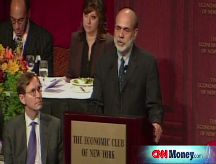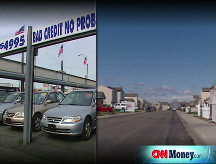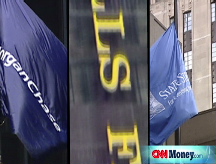Another huge Dow loss
Blue-chip indicator drubbed 733 points - 2nd biggest point loss ever - as recession fears resurface.
 |
| The second-biggest point drop ever wipes out $1.1 trillion in market value. |

NEW YORK (CNNMoney.com) -- Recession talk scared Wall Street Wednesday, sending the Dow Jones industrial average to its second biggest one-day point loss ever.
A weak retail sales report and dour forecasts from the Federal Reserve, coupled with sober comments from Fed Chairman Ben Bernanke, sent stocks tumbling.
The Dow Jones industrial average (INDU) fell 733 points, its second biggest one-day point loss ever, second only to Sept. 29 of this year, when the House of Representatives initially rejected the government's $700 billion bank bailout plan.
Wednesday's decline was equal to around 7.9%, the Dow's biggest one-day percentage loss since Oct. 26, 1987.
The Standard & Poor's 500 (SPX) index lost 90 points, its second-worst one-day point loss ever, also second only to Sept. 29. The loss was equal to 9%, its second biggest slide on a percentage basis since Oct. 19, 1987, a.k.a. Black Monday.
The Nasdaq composite (COMP) lost 8.5% and closed at a new low for 2008, its worst level since June 30, 2003. The decline of 8.5% was its biggest one-day percentage loss since Aug. 31, 1998. On a point basis, it didn't rate among the 20 worst days.
The decline Wednesday equaled a loss of $1.1 trillion in market value, as measured by the Dow Jones Wilshire 5000, the broadest measure of the stock market. It was the second-biggest one-day loss ever, following Sept. 29.
"It's stunning," said Donald Selkin, chief market strategist at National Securities. He said Wednesday's selloff was an accumulation of all the negatives that are overlapping.
"The poor economic reality is being reflected in the market," he said.
The day's news included retail sales at a 3-year low, a reading on manufacturing in the New York area at an all-time low, the Fed's weak forecast and comments from Bernanke.
"The economy is the issue right now," said Timothy Ghriskey, chief investment officer at Solaris Asset Management. "It was clear in Bernanke's speech today, in the retail sales report and in the stock market reaction."
Ghriskey said the risk level is high now "because we don't know the duration or the depth of an economic downturn."
Additionally, Wall Street is impatiently waiting for the many initiatives that have been announced to start loosening up the still-sluggish credit market, a process that won't happen overnight.
"The Fed and Treasury have thrown the entire arsenal at the problem and those things will work, but the market wants to see it work right away," said Jim Dunigan, chief investment officer at PNC Wealth Management.
The credit market showed some signs of easing, as a key overnight bank lending rate fell. But the improvement was slowgoing and failed to reassure investors. Global markets were mostly lower.
Investors are also now dealing with the "around-the-clock-effect," Selkin said. He said that barring some big news in the next few hours, Wall Street's slide will send Asian markets lower, which will drag on European markets, and in turn hitting Wall Street again Thursday.
Treasury prices gained Wednesday, lowering the corresponding yields. The dollar gained versus the yen and fell against the euro. Oil and gas prices slipped, while gold prices rose.
Calling a recession: San Francisco Federal Reserve Bank President Janet Yellen said the U.S. economy "appears to be in a recession," something many economists, but few Fed officials, have said. Yellen isn't a voting member of the Fed's policy-setting committee this year but is nonetheless seen as influential. (Full story)
Federal Reserve Chairman Ben Bernanke, speaking in the afternoon, said that while policymakers now have the tools they need to fix the financial and credit markets, the economic rebound will take time. (Full story)
The Fed's 'beige book' reading on economic activity, released in the afternoon, showed weakness in all 12 districts. The outlook was also pessimistic, with businesses unable to access much-needed credit.
The lack of available credit has punished the already weak economy, making it difficult for businesses to function on a daily basis and for consumers to get loans.
"The market seems to be waking up to the fact that we're in a recession," Dunigan said.
He said he's not clear as to why this is a surprise to the market, as the recession has been well forecasted by economists, if not the Federal Reserve and National Bureau of Economic Research, which officially "calls" a recession. However, he said that it may be that since the government and world banks have addressed the worst fears about the credit crisis, investors are now returning the focus to the broad economy.
Better-than-expected quarterly results from Intel, Coca-Cola, Wells Fargo, JPMorgan Chase and a host of regional banks had little impact amid worries about a recession.
Wall Street's lack of confidence: Although investors have welcomed many of the steps the government and world banks have taken to get money flowing again, investors remain skittish. That's partly because a lot of the programs won't kick in until several months from now.
"After all the damage that's been done, it's going to take a while for people to feel confident again," said Joseph Saluzzi, co-head of equity trading at Themis Trading..
Stocks rallied sharply Monday, with the Dow up 936 points or 11.1%, its best one-day point gain ever and best one-day percentage gain since 1933. The advance was fueled by bets that the United States would follow Europe in pouring money directly into banks in exchange for shares, as part of the $750 billion bailout plan.
But investors took a "sell the news" approach Tuesday after the government detailed plans to invest at least $250 billion in the nation's banks. The Treasury said it will start by investing $125 billion in nine leading banks. (Will it work?)
On Wednesday, leaders of the Group of Eight (G8) economies said that they would hold a global financial crisis summit before the end of the year.
Last week was Wall Street's worst ever, as the Dow capped a stunning eight-session selloff that cut 2,400 points and 22% off the blue-chip indicator. That erased $2.4 trillion in market value from the Dow Jones Wilshire 5000, the broadest measure of the stock market.
Many market pros are cautiously optimistic that Friday's lows represent the lows of the bear market, or a bottom.
Economy: Consumer spending has remained strained, despite the drop in gas prices over the last 4 weeks.
Retail sales fell 1.2% in September, the biggest drop in three years, after falling a revised 0.4% in August. Economists surveyed by Briefing.com thought sales would fall 0.7%. Sales excluding volatile auto sales fell 0.6%, versus forecasts for a drop of 0.2%. Sales excluding autos fell a revised 0.9% in August. (Full story)
The September Producer Price Index (PPI), a measure of inflation at the wholesale level, fell 0.4%, in line with forecasts and reflecting the decline in energy prices. PPI fell 0.9% in August. So-called core PPI, which strips out volatile food and energy prices, rose 0.4% in September, versus forecasts for a rise of 0.2%. Core PPI rose 0.2% in August.
The NY Empire State index, a regional manufacturing report, slumped to negative 24.6 from negative 7.4 in the previous month. Economists thought it would fall to negative 10. Any negative reading shows weakness, while a positive reading shows growth.
Late Tuesday, the government said the U.S. budget deficit swelled to $454.8 billion, the highest level in history.
Earnings: A number of companies reported better-than-expected quarterly results late Tuesday and early Wednesday, including a slew of banks.
JPMorgan Chase (JPM, Fortune 500) surprised investors Wednesday morning by reporting a profit versus expectations for a loss. But the company's net income plunged 84% due to charges connected to its purchase of Washington Mutual. It also took $3.6 billion in writedowns related to bad mortgage bets. Shares fell 2%. (Full story)
Wells Fargo (WFC, Fortune 500) posted weaker profit on writedowns and credit losses, but results were better than expected. The bank said it expects to complete its $11.7 billion purchase of Wachovia by the end of the fourth quarter. Shares rose 2%. (Full story)
JPMorgan and Wells Fargo have fared better than many of their peers in the credit crisis. Still, the two banks are among the nine that will participate in the Treasury plan.
Late Tuesday, Intel (INTC, Fortune 500) reported higher quarterly earnings that edged estimates on higher revenue that was short of forecasts. The chipmaker also reported a bigger-than-expected rise in gross margins, a key measure of profitability. Shares fell 1.5% Wednesday.
And Coca-Cola (KO, Fortune 500) reported higher quarterly earnings that beat estimates on higher sales that missed estimates. Coke's Wednesday morning report followed Pepsi's weaker results Tuesday. Coke shares gained 3% Wednesday.
JPMorgan, Intel and Coke are all Dow stocks. But Coke was the only gainer among the 30 Dow components.
The Dow's biggest losers were financial components American Express (AXP, Fortune 500) and Citigroup (C, Fortune 500), and energy components Chevron (CVX, Fortune 500) and Exxon Mobil (XOM, Fortune 500).
Third-quarter earnings are currently on track to have fallen 9.8% from a year ago, according to the latest estimates from Thomson Reuters.
After the close Wednesday, eBay (EBAY, Fortune 500) posted a higher-than-expected quarterly profit, but warned fourth-quarter results won't meet forecasts. The stock slid 5.5% in extended-hours trading.
Credit market: Some bank lending indicators improved, in a sign that the recent global initiatives to get money flowing again may be starting to work. (Full story)
Libor, the overnight bank-to-bank lending rate, fell to 2.14% from 2.18% Tuesday, according to Bloomberg.com.
The three-month Libor, what banks charge each other to borrow for three months, fell to 4.55% from 4.64% Tuesday.
The Libor-OIS spread, a measure of cash scarcity, decreased to 3.35% from 3.39% Tuesday and a record high of 3.67% Friday.
The TED spread, which is the difference between what banks pay to borrow from each other for three months and what the Treasury pays, widened to 4.37% from 4.30% late Tuesday. The spread hit a record 4.65% Friday. The wider the spread, the more reluctant banks are to lend to each other.
Treasury prices rallied, lowering the yield on the 10-year note to 3.97% from 4.07% late Tuesday. Treasury prices and yields move in opposite directions.
But the yield on the 3-month Treasury bill, seen by many as the safest place to put money in the short term, fell to 0.20% from 0.25% late Tuesday, showing investors were still willing to take a meager return on their money rather than risk it on stocks. Last month, the yield on the 3-month bill skidded to a 68-year low around 0%.
Other markets: U.S. light crude oil for November delivery fell $4.09 to settle at $74.54 a barrel on the New York Mercantile Exchange, a more than 13-month low. Oil prices have tumbled on bets of slowing demand since the price of crude hit an all-time high of $147.27 a barrel on July 11.
Gasoline prices fell another 3.8 cents overnight, to a national average of $3.125 a gallon, according to a survey of credit card activity by motorist group AAA. It was the 28th consecutive day that prices have decreased - in the past month alone, they're down more than 73 cents a gallon.
COMEX gold for December delivery fell 50 cents to settle at $839 an ounce.
In currency trading, the dollar rose against the euro and fell versus the yen. ![]()




